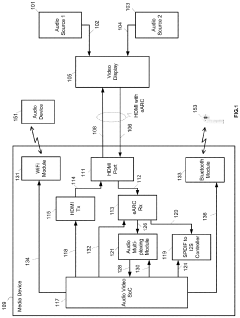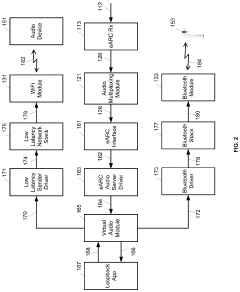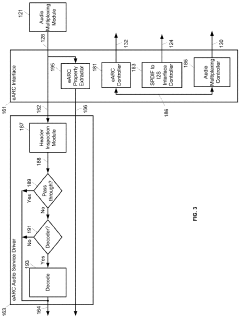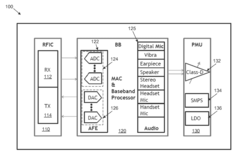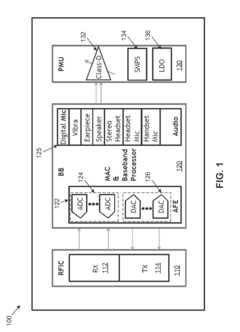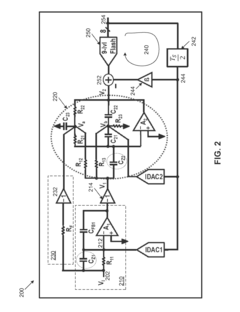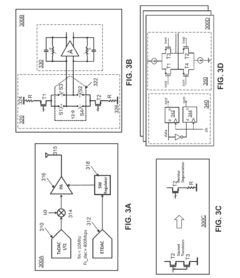How LDAC Syncs with Emerging Audio Technologies?
JUL 4, 20258 MIN READ
Generate Your Research Report Instantly with AI Agent
Patsnap Eureka helps you evaluate technical feasibility & market potential.
LDAC Evolution and Objectives
LDAC, developed by Sony in 2015, represents a significant milestone in high-resolution audio codec technology. This advanced audio coding technology has evolved to address the growing demand for superior wireless audio quality in an era of increasing digital music consumption and wireless device proliferation. LDAC's primary objective is to deliver near-lossless audio quality over Bluetooth connections, a feat previously thought unattainable due to bandwidth limitations.
The evolution of LDAC is closely tied to the broader advancements in audio technology and consumer electronics. Initially designed to support high-resolution audio up to 24-bit/96 kHz, LDAC has since expanded its capabilities to handle even higher quality audio streams, including 24-bit/192 kHz. This progression aligns with the industry's push towards higher fidelity audio experiences across various platforms and devices.
A key objective of LDAC has been to overcome the traditional limitations of Bluetooth audio transmission. By employing sophisticated encoding algorithms and adaptive bit rate technology, LDAC aims to maximize the available bandwidth, allowing for transmission rates of up to 990 kbps. This is a significant improvement over standard Bluetooth codecs, which typically operate at much lower bit rates.
As the audio landscape continues to evolve, LDAC's objectives have expanded to include compatibility with emerging audio technologies. This includes integration with spatial audio formats, support for multi-channel audio, and adaptability to new wireless communication standards. The goal is to ensure that LDAC remains at the forefront of wireless audio technology, capable of delivering immersive and high-quality audio experiences across a wide range of devices and use cases.
Another critical objective in LDAC's evolution is energy efficiency. As wireless devices become increasingly prevalent, there is a growing need for audio codecs that can deliver high-quality sound without significantly impacting battery life. LDAC's development has thus focused on optimizing its encoding and decoding processes to minimize power consumption while maintaining audio quality.
Looking ahead, LDAC's evolution is likely to focus on further improving its adaptability to varying network conditions and device capabilities. This may involve more sophisticated dynamic bit rate adjustment algorithms and enhanced error correction techniques to ensure consistent audio quality even in challenging wireless environments. Additionally, as new audio formats and standards emerge, LDAC will need to evolve to support these technologies while maintaining backward compatibility with existing devices and systems.
The evolution of LDAC is closely tied to the broader advancements in audio technology and consumer electronics. Initially designed to support high-resolution audio up to 24-bit/96 kHz, LDAC has since expanded its capabilities to handle even higher quality audio streams, including 24-bit/192 kHz. This progression aligns with the industry's push towards higher fidelity audio experiences across various platforms and devices.
A key objective of LDAC has been to overcome the traditional limitations of Bluetooth audio transmission. By employing sophisticated encoding algorithms and adaptive bit rate technology, LDAC aims to maximize the available bandwidth, allowing for transmission rates of up to 990 kbps. This is a significant improvement over standard Bluetooth codecs, which typically operate at much lower bit rates.
As the audio landscape continues to evolve, LDAC's objectives have expanded to include compatibility with emerging audio technologies. This includes integration with spatial audio formats, support for multi-channel audio, and adaptability to new wireless communication standards. The goal is to ensure that LDAC remains at the forefront of wireless audio technology, capable of delivering immersive and high-quality audio experiences across a wide range of devices and use cases.
Another critical objective in LDAC's evolution is energy efficiency. As wireless devices become increasingly prevalent, there is a growing need for audio codecs that can deliver high-quality sound without significantly impacting battery life. LDAC's development has thus focused on optimizing its encoding and decoding processes to minimize power consumption while maintaining audio quality.
Looking ahead, LDAC's evolution is likely to focus on further improving its adaptability to varying network conditions and device capabilities. This may involve more sophisticated dynamic bit rate adjustment algorithms and enhanced error correction techniques to ensure consistent audio quality even in challenging wireless environments. Additionally, as new audio formats and standards emerge, LDAC will need to evolve to support these technologies while maintaining backward compatibility with existing devices and systems.
Audio Market Trends Analysis
The global audio market is experiencing significant growth and transformation, driven by technological advancements and changing consumer preferences. The market size for audio equipment and technologies is projected to reach substantial figures in the coming years, with a compound annual growth rate (CAGR) that reflects strong industry momentum. This growth is fueled by several key trends that are reshaping the audio landscape.
One of the most prominent trends is the increasing demand for wireless audio solutions. Consumers are gravitating towards cord-free experiences, leading to a surge in popularity for true wireless stereo (TWS) earbuds and Bluetooth-enabled speakers. This shift is not only influencing personal audio devices but also impacting professional audio equipment and home entertainment systems.
High-resolution audio is another trend gaining traction in the market. As consumers become more discerning about audio quality, there is a growing appetite for lossless and high-fidelity audio formats. This trend aligns closely with the capabilities of advanced audio codecs like LDAC, which offers higher bitrates and improved sound quality over Bluetooth connections.
The integration of smart features and voice assistants into audio devices is reshaping user interactions and expanding functionality. Smart speakers and voice-controlled audio systems are becoming increasingly prevalent in homes and offices, driving market growth and innovation in AI-powered audio technologies.
Immersive audio experiences, including spatial audio and 3D sound technologies, are emerging as significant market drivers. These technologies are finding applications not only in entertainment and gaming but also in virtual and augmented reality environments, creating new opportunities for audio product development.
The rise of streaming services and digital content consumption is influencing audio hardware design and capabilities. Audio devices are increasingly being optimized for streaming platforms, with features that enhance connectivity, reduce latency, and improve overall listening experiences for digital content.
In the professional audio sector, there is a growing demand for networked audio solutions and software-defined audio systems. These technologies are transforming live sound, broadcast, and studio environments, offering greater flexibility and scalability.
The automotive audio market is also experiencing significant growth, with advanced in-car entertainment systems and premium audio offerings becoming key differentiators for vehicle manufacturers. This sector is seeing innovations in spatial audio, active noise cancellation, and personalized sound zones within vehicles.
One of the most prominent trends is the increasing demand for wireless audio solutions. Consumers are gravitating towards cord-free experiences, leading to a surge in popularity for true wireless stereo (TWS) earbuds and Bluetooth-enabled speakers. This shift is not only influencing personal audio devices but also impacting professional audio equipment and home entertainment systems.
High-resolution audio is another trend gaining traction in the market. As consumers become more discerning about audio quality, there is a growing appetite for lossless and high-fidelity audio formats. This trend aligns closely with the capabilities of advanced audio codecs like LDAC, which offers higher bitrates and improved sound quality over Bluetooth connections.
The integration of smart features and voice assistants into audio devices is reshaping user interactions and expanding functionality. Smart speakers and voice-controlled audio systems are becoming increasingly prevalent in homes and offices, driving market growth and innovation in AI-powered audio technologies.
Immersive audio experiences, including spatial audio and 3D sound technologies, are emerging as significant market drivers. These technologies are finding applications not only in entertainment and gaming but also in virtual and augmented reality environments, creating new opportunities for audio product development.
The rise of streaming services and digital content consumption is influencing audio hardware design and capabilities. Audio devices are increasingly being optimized for streaming platforms, with features that enhance connectivity, reduce latency, and improve overall listening experiences for digital content.
In the professional audio sector, there is a growing demand for networked audio solutions and software-defined audio systems. These technologies are transforming live sound, broadcast, and studio environments, offering greater flexibility and scalability.
The automotive audio market is also experiencing significant growth, with advanced in-car entertainment systems and premium audio offerings becoming key differentiators for vehicle manufacturers. This sector is seeing innovations in spatial audio, active noise cancellation, and personalized sound zones within vehicles.
LDAC Technical Challenges
LDAC, as an advanced audio codec developed by Sony, faces several technical challenges in its integration with emerging audio technologies. One of the primary hurdles is maintaining high-quality audio transmission while minimizing latency. As new audio applications demand real-time processing and seamless synchronization, LDAC must evolve to meet these requirements without compromising its core strength of high-resolution audio delivery.
Another significant challenge lies in power consumption optimization. LDAC's complex encoding and decoding processes require substantial computational resources, which can drain battery life in portable devices. As the market for wireless audio devices continues to expand, striking a balance between audio quality and energy efficiency becomes increasingly crucial.
Compatibility issues also pose a considerable challenge for LDAC. While it offers superior audio quality, its proprietary nature limits widespread adoption across different platforms and devices. This creates a fragmented ecosystem where not all devices can take full advantage of LDAC's capabilities, potentially hindering its growth and integration with emerging audio technologies.
The ever-increasing demand for multi-channel audio support presents another technical hurdle for LDAC. As immersive audio experiences gain popularity in various applications, from gaming to virtual reality, LDAC must adapt to efficiently handle multiple audio channels without sacrificing quality or introducing significant latency.
Scalability is a critical challenge as audio streaming services continue to evolve. LDAC needs to accommodate various bitrates and adapt to changing network conditions seamlessly. This requires sophisticated algorithms that can dynamically adjust compression levels while maintaining optimal audio quality across different scenarios.
Furthermore, LDAC faces challenges in integrating with emerging spatial audio technologies. As 3D audio and object-based audio formats become more prevalent, LDAC must evolve to support these complex audio representations efficiently, ensuring accurate spatial positioning and immersive soundscapes.
Lastly, the rapid advancement of AI and machine learning in audio processing presents both opportunities and challenges for LDAC. Incorporating these technologies to enhance audio quality, reduce artifacts, and improve overall performance requires significant research and development efforts. Balancing the benefits of AI-driven improvements with the computational overhead and potential impact on latency remains a complex technical challenge.
Another significant challenge lies in power consumption optimization. LDAC's complex encoding and decoding processes require substantial computational resources, which can drain battery life in portable devices. As the market for wireless audio devices continues to expand, striking a balance between audio quality and energy efficiency becomes increasingly crucial.
Compatibility issues also pose a considerable challenge for LDAC. While it offers superior audio quality, its proprietary nature limits widespread adoption across different platforms and devices. This creates a fragmented ecosystem where not all devices can take full advantage of LDAC's capabilities, potentially hindering its growth and integration with emerging audio technologies.
The ever-increasing demand for multi-channel audio support presents another technical hurdle for LDAC. As immersive audio experiences gain popularity in various applications, from gaming to virtual reality, LDAC must adapt to efficiently handle multiple audio channels without sacrificing quality or introducing significant latency.
Scalability is a critical challenge as audio streaming services continue to evolve. LDAC needs to accommodate various bitrates and adapt to changing network conditions seamlessly. This requires sophisticated algorithms that can dynamically adjust compression levels while maintaining optimal audio quality across different scenarios.
Furthermore, LDAC faces challenges in integrating with emerging spatial audio technologies. As 3D audio and object-based audio formats become more prevalent, LDAC must evolve to support these complex audio representations efficiently, ensuring accurate spatial positioning and immersive soundscapes.
Lastly, the rapid advancement of AI and machine learning in audio processing presents both opportunities and challenges for LDAC. Incorporating these technologies to enhance audio quality, reduce artifacts, and improve overall performance requires significant research and development efforts. Balancing the benefits of AI-driven improvements with the computational overhead and potential impact on latency remains a complex technical challenge.
Current LDAC Implementation
01 Audio codec technology for wireless devices
LDAC is an advanced audio codec technology developed for high-quality wireless audio transmission. It enables the transmission of high-resolution audio data over Bluetooth connections, providing improved sound quality compared to standard Bluetooth codecs. LDAC supports various bit rates and can adapt to different network conditions to maintain optimal audio performance.- LDAC audio codec implementation: LDAC is a high-quality audio codec developed for Bluetooth audio transmission. It enables high-resolution audio streaming over Bluetooth connections, offering improved sound quality compared to standard codecs. LDAC supports various bit rates and can adapt to different network conditions to maintain optimal audio performance.
- LDAC integration in audio devices: LDAC technology is integrated into various audio devices, including smartphones, headphones, and speakers. This integration allows for enhanced wireless audio transmission, providing users with a superior listening experience. Manufacturers implement LDAC in their products to offer high-fidelity sound reproduction over Bluetooth connections.
- LDAC compatibility with audio systems: LDAC is designed to be compatible with a wide range of audio systems and platforms. This includes integration with mobile operating systems, audio processing chips, and various audio playback software. The compatibility ensures that LDAC can be widely adopted across different devices and ecosystems, providing a seamless high-quality audio experience for users.
- LDAC power efficiency improvements: Efforts are made to improve the power efficiency of LDAC implementation in audio devices. This includes optimizing the codec's processing algorithms and hardware integration to reduce power consumption during audio transmission. These improvements aim to extend battery life in wireless audio devices while maintaining high-quality sound output.
- LDAC in multi-channel audio applications: LDAC technology is applied in multi-channel audio setups, enabling high-quality wireless transmission for surround sound systems. This application extends LDAC's capabilities beyond stereo audio, allowing for immersive audio experiences in home theater systems and other multi-speaker setups while maintaining the benefits of wireless connectivity.
02 Integration with audio processing systems
LDAC can be integrated into various audio processing systems and devices. This includes implementation in smartphones, wireless headphones, speakers, and other audio equipment. The technology can work alongside other audio processing features such as noise cancellation and spatial audio to enhance the overall listening experience.Expand Specific Solutions03 Compatibility with Bluetooth standards
LDAC is designed to be compatible with existing Bluetooth standards while offering enhanced audio capabilities. It can operate within the Bluetooth protocol stack and coexist with other Bluetooth profiles. This ensures broad compatibility with a wide range of devices and allows for seamless integration into existing audio ecosystems.Expand Specific Solutions04 Power efficiency and battery life optimization
LDAC technology incorporates power efficiency features to optimize battery life in wireless audio devices. It employs adaptive bit rate control and efficient encoding algorithms to reduce power consumption while maintaining high audio quality. This is particularly important for portable devices with limited battery capacity.Expand Specific Solutions05 Application in multi-channel audio systems
LDAC can be applied in multi-channel audio systems, supporting surround sound and immersive audio experiences. It allows for the transmission of multiple audio channels over Bluetooth, enabling more complex audio setups in wireless environments. This makes it suitable for home theater systems, gaming setups, and other multi-speaker configurations.Expand Specific Solutions
Key LDAC Industry Players
The LDAC (Low Latency Audio Codec) technology is currently in a growth phase within the audio industry, with increasing market adoption and integration. The global wireless audio market, which includes LDAC-compatible devices, is projected to reach significant size in the coming years. Technologically, LDAC is maturing rapidly, with major players like Sony (the developer of LDAC), Samsung Electronics, and LG Electronics incorporating it into their products. Companies such as Dolby Laboratories and Harman Becker Automotive Systems are also contributing to the advancement of high-quality audio codecs, potentially influencing LDAC's evolution. As the demand for high-resolution wireless audio grows, LDAC is likely to see increased competition and collaboration with other emerging audio technologies.
Huawei Technologies Co., Ltd.
Technical Solution: Huawei has developed its own high-resolution audio codec, HWA (Hi-Res Wireless Audio), which is designed to work alongside LDAC. This dual-codec approach allows Huawei devices to switch between LDAC and HWA depending on the connected device and network conditions. Huawei has also focused on optimizing LDAC performance on their Kirin chipsets, achieving lower power consumption and improved stability[9]. The company is working on integrating LDAC with their AI capabilities to provide context-aware audio adjustments and personalized listening experiences[10].
Strengths: Dual-codec approach for flexibility, optimized hardware integration. Weaknesses: Potential compatibility issues with non-Huawei devices.
Fraunhofer-Gesellschaft eV
Technical Solution: Fraunhofer, known for developing the MP3 format, has been working on integrating LDAC with their latest audio codecs. Their approach focuses on combining LDAC's high bitrate capabilities with advanced psychoacoustic models to achieve even better perceived audio quality at lower bitrates. Fraunhofer has also developed techniques to enhance LDAC's performance in challenging wireless environments, such as areas with high interference[7]. Additionally, they are exploring ways to extend LDAC's capabilities to multi-channel audio for immersive sound experiences[8].
Strengths: Expertise in audio codec development, potential for significant advancements in audio quality. Weaknesses: Research-focused approach may lead to slower commercial implementation.
LDAC Core Technology Review
Audio Return Channel Data Loopback
PatentActiveUS20210098011A1
Innovation
- A media device substitutes an externally generated clock derived from a local crystal oscillator for the missing sampling clock, synchronizing it with the input sampling clock frequency, and switches back when the input clock reappears, while inserting zero padding to mitigate sound glitches, and optionally buffers audio data during clock transitions to maintain sound continuity.
Analog and audio mixed-signal front end for 4g/LTE cellular system-on-chip
PatentActiveUS20150194979A1
Innovation
- The integration of a CMOS cellular system-on-chip (SoC) with an embedded analog front-end (AFE) and enhanced audio capabilities, utilizing a wideband sigma-delta architecture for analog-to-digital converters (ADCs) and push-pull digital-to-analog converters (DACs), along with optimized filter structures and power management units, to achieve high signal-to-noise-and-distortion ratio (SNDR) and reduce power consumption.
LDAC Interoperability
LDAC, as a high-resolution audio codec developed by Sony, has shown significant potential for interoperability with emerging audio technologies. This compatibility is crucial for maintaining LDAC's relevance in the rapidly evolving audio landscape.
One key area of interoperability is with spatial audio technologies. LDAC's high bitrate and low latency characteristics make it well-suited for transmitting complex spatial audio data. As immersive audio experiences gain popularity in both consumer and professional applications, LDAC's ability to seamlessly integrate with spatial audio codecs and processing algorithms becomes increasingly important.
Another emerging technology that LDAC syncs well with is adaptive streaming. The codec's variable bitrate capabilities allow it to dynamically adjust to changing network conditions, ensuring optimal audio quality even in challenging wireless environments. This adaptability aligns well with the growing trend of adaptive streaming in music and video platforms.
LDAC also demonstrates compatibility with AI-driven audio enhancement technologies. Its high-fidelity audio transmission preserves the nuances necessary for AI algorithms to effectively analyze and optimize sound in real-time. This synergy opens up possibilities for advanced noise cancellation, personalized audio profiles, and intelligent sound mixing.
In the realm of voice assistants and smart home devices, LDAC's low latency and high-quality audio transmission contribute to improved voice recognition accuracy and more natural-sounding responses. This interoperability enhances the overall user experience in smart ecosystems.
LDAC's compatibility with emerging audio hardware is also noteworthy. As new wireless audio devices enter the market, such as true wireless earbuds with advanced features, LDAC's ability to deliver high-quality audio over Bluetooth becomes increasingly valuable. Its integration with the latest Bluetooth audio standards ensures that it remains relevant in the evolving hardware landscape.
Furthermore, LDAC's interoperability extends to the automotive industry, where high-quality audio is becoming a differentiating factor. Its ability to work seamlessly with in-car entertainment systems and integrate with emerging vehicle-to-everything (V2X) communication technologies positions it well for future automotive applications.
As the audio industry continues to evolve, LDAC's ongoing development and adaptation to new technologies will be crucial. Its ability to sync with emerging audio technologies not only enhances its value proposition but also contributes to the overall advancement of the audio ecosystem.
One key area of interoperability is with spatial audio technologies. LDAC's high bitrate and low latency characteristics make it well-suited for transmitting complex spatial audio data. As immersive audio experiences gain popularity in both consumer and professional applications, LDAC's ability to seamlessly integrate with spatial audio codecs and processing algorithms becomes increasingly important.
Another emerging technology that LDAC syncs well with is adaptive streaming. The codec's variable bitrate capabilities allow it to dynamically adjust to changing network conditions, ensuring optimal audio quality even in challenging wireless environments. This adaptability aligns well with the growing trend of adaptive streaming in music and video platforms.
LDAC also demonstrates compatibility with AI-driven audio enhancement technologies. Its high-fidelity audio transmission preserves the nuances necessary for AI algorithms to effectively analyze and optimize sound in real-time. This synergy opens up possibilities for advanced noise cancellation, personalized audio profiles, and intelligent sound mixing.
In the realm of voice assistants and smart home devices, LDAC's low latency and high-quality audio transmission contribute to improved voice recognition accuracy and more natural-sounding responses. This interoperability enhances the overall user experience in smart ecosystems.
LDAC's compatibility with emerging audio hardware is also noteworthy. As new wireless audio devices enter the market, such as true wireless earbuds with advanced features, LDAC's ability to deliver high-quality audio over Bluetooth becomes increasingly valuable. Its integration with the latest Bluetooth audio standards ensures that it remains relevant in the evolving hardware landscape.
Furthermore, LDAC's interoperability extends to the automotive industry, where high-quality audio is becoming a differentiating factor. Its ability to work seamlessly with in-car entertainment systems and integrate with emerging vehicle-to-everything (V2X) communication technologies positions it well for future automotive applications.
As the audio industry continues to evolve, LDAC's ongoing development and adaptation to new technologies will be crucial. Its ability to sync with emerging audio technologies not only enhances its value proposition but also contributes to the overall advancement of the audio ecosystem.
LDAC Energy Efficiency
LDAC's energy efficiency is a critical aspect of its integration with emerging audio technologies. As high-resolution audio streaming becomes increasingly popular, the demand for efficient codec solutions that can deliver superior sound quality while minimizing power consumption has grown significantly.
LDAC employs advanced compression techniques to reduce the amount of data transmitted, thereby lowering the energy requirements for both encoding and decoding processes. This efficiency is particularly important for battery-powered devices such as wireless headphones and portable speakers, where extended playback time is a key selling point.
The codec's adaptive bit rate feature allows it to dynamically adjust the transmission rate based on the available bandwidth and connection stability. This adaptability not only ensures a consistent audio experience but also optimizes power usage by avoiding unnecessary data transmission when network conditions are less than ideal.
LDAC's energy efficiency is further enhanced by its compatibility with Bluetooth Low Energy (BLE) technology. This synergy allows for reduced power consumption during device discovery and connection establishment phases, contributing to overall battery life improvements in LDAC-enabled devices.
Recent advancements in LDAC have focused on optimizing its algorithmic efficiency, resulting in reduced computational complexity for both encoding and decoding processes. These improvements translate to lower CPU usage and, consequently, decreased power draw on both source and receiving devices.
The codec's energy efficiency also plays a crucial role in its adoption by manufacturers of true wireless stereo (TWS) earbuds. As these compact devices have limited battery capacity, LDAC's ability to deliver high-quality audio with minimal power overhead has made it an attractive option for premium TWS products.
Looking ahead, LDAC's energy efficiency is expected to improve further through integration with emerging audio processing technologies. Machine learning algorithms are being explored to predict and optimize codec parameters in real-time, potentially leading to even greater power savings without compromising audio quality.
As the audio industry continues to evolve, LDAC's focus on energy efficiency positions it well to sync with future technologies that prioritize both performance and sustainability. This alignment with broader industry trends towards eco-friendly consumer electronics ensures LDAC's relevance in the rapidly advancing landscape of audio technologies.
LDAC employs advanced compression techniques to reduce the amount of data transmitted, thereby lowering the energy requirements for both encoding and decoding processes. This efficiency is particularly important for battery-powered devices such as wireless headphones and portable speakers, where extended playback time is a key selling point.
The codec's adaptive bit rate feature allows it to dynamically adjust the transmission rate based on the available bandwidth and connection stability. This adaptability not only ensures a consistent audio experience but also optimizes power usage by avoiding unnecessary data transmission when network conditions are less than ideal.
LDAC's energy efficiency is further enhanced by its compatibility with Bluetooth Low Energy (BLE) technology. This synergy allows for reduced power consumption during device discovery and connection establishment phases, contributing to overall battery life improvements in LDAC-enabled devices.
Recent advancements in LDAC have focused on optimizing its algorithmic efficiency, resulting in reduced computational complexity for both encoding and decoding processes. These improvements translate to lower CPU usage and, consequently, decreased power draw on both source and receiving devices.
The codec's energy efficiency also plays a crucial role in its adoption by manufacturers of true wireless stereo (TWS) earbuds. As these compact devices have limited battery capacity, LDAC's ability to deliver high-quality audio with minimal power overhead has made it an attractive option for premium TWS products.
Looking ahead, LDAC's energy efficiency is expected to improve further through integration with emerging audio processing technologies. Machine learning algorithms are being explored to predict and optimize codec parameters in real-time, potentially leading to even greater power savings without compromising audio quality.
As the audio industry continues to evolve, LDAC's focus on energy efficiency positions it well to sync with future technologies that prioritize both performance and sustainability. This alignment with broader industry trends towards eco-friendly consumer electronics ensures LDAC's relevance in the rapidly advancing landscape of audio technologies.
Unlock deeper insights with Patsnap Eureka Quick Research — get a full tech report to explore trends and direct your research. Try now!
Generate Your Research Report Instantly with AI Agent
Supercharge your innovation with Patsnap Eureka AI Agent Platform!
